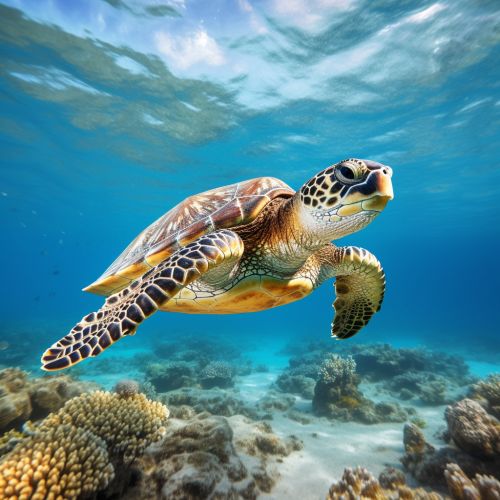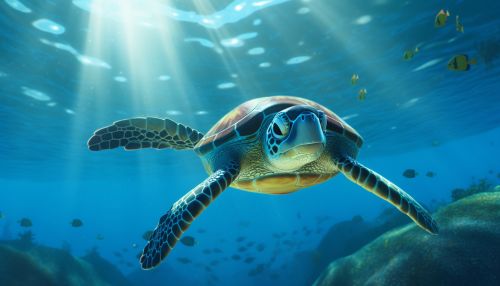Sea Turtle
Introduction
Sea turtles are marine reptiles that belong to the family Cheloniidae and the superfamily Chelonioidea. They are one of the oldest creatures on earth, with a history dating back to the time of the dinosaurs. Sea turtles are known for their long migrations, some species travel more than 1,000 miles to reach their nesting grounds.


Anatomy and Morphology
Sea turtles have a distinctive body shape with a large, streamlined shell and flippers instead of legs. The shell, or carapace, is made up of a series of fused bones covered with horny plates called scutes. The underside of the shell, known as the plastron, is lighter and less heavily armored.
Sea turtles have a beak-like mouth, no teeth, and a short neck that cannot be retracted into the shell. Their eyes have adapted to function well both in the aquatic environment and on land. Sea turtles have a salt gland which helps to remove excess salt, a critical adaptation to their marine lifestyle.
Species
There are seven extant species of sea turtles: the green, loggerhead, Kemp's Ridley, Olive Ridley, hawksbill, flatback, and leatherback. Each species has unique characteristics and behaviors that distinguish them from one another.
Life Cycle and Reproduction
Sea turtles have a complex life cycle that involves both land and sea. Females return to the same beach where they were born to lay their eggs, a process known as natal homing. After mating at sea, the female comes ashore at night, digs a hole in the sand, and lays her clutch of eggs.
The eggs incubate for about two months. When the hatchlings emerge, they make their way to the sea. Only a small percentage of hatchlings survive to adulthood, with many falling prey to predators or human-related threats.
Diet and Feeding Habits
Sea turtles are omnivores, feeding on a variety of plant and animal life. The diet varies greatly among species and even among different age groups within the same species. For example, green sea turtles are primarily herbivores, feeding on seagrasses and algae, while loggerhead sea turtles are omnivores, consuming a variety of invertebrates like crabs, mollusks, and jellyfish.
Sea turtles are known for their remarkable navigational abilities, often traveling hundreds or even thousands of miles between feeding grounds and nesting beaches. They use a combination of innate and learned cues to navigate, including the Earth's magnetic field, water currents, temperature gradients, and celestial cues.
Threats and Conservation
Sea turtles face numerous threats, both natural and human-induced. These include predation, habitat loss, climate change, pollution, and incidental capture in fishing gear, also known as bycatch.
Conservation efforts for sea turtles are multifaceted and include measures such as protection of nesting beaches, reduction of bycatch, rehabilitation of injured turtles, and public education campaigns. Many sea turtle species are currently listed as endangered or threatened under the Endangered Species Act.
